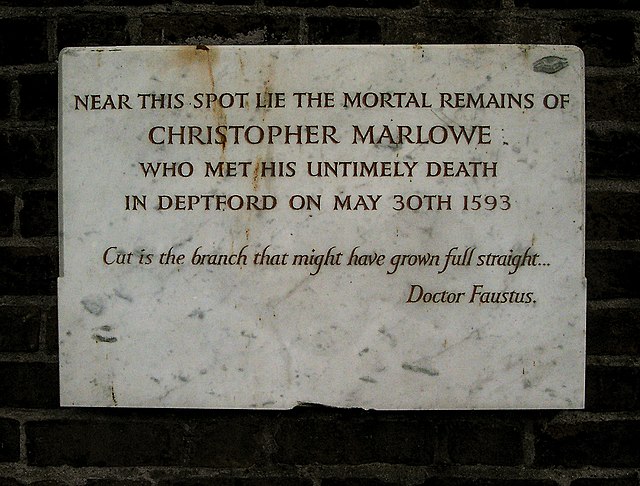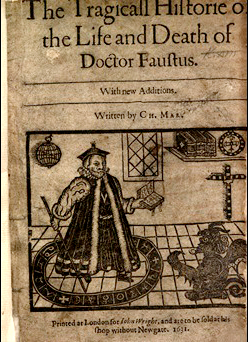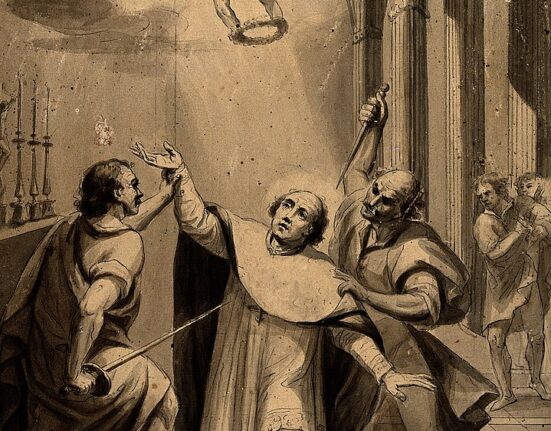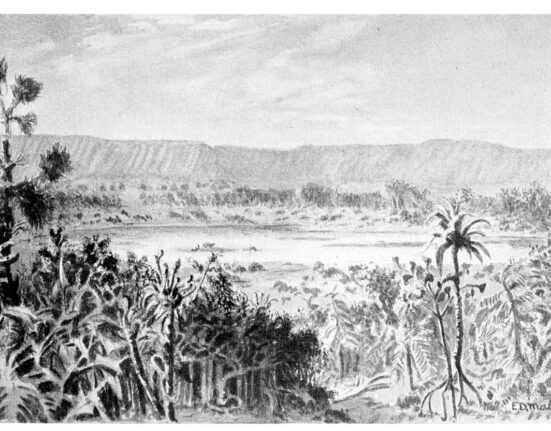Who is Christopher Marlowe?
Christopher Marlowe, also referred to as “Kit” Marlowe, led a short but impactful life. Born in 1564, the young Marlowe studied at The King’s School in Canterbury on a scholarship before earning another scholarship to study at Corpus Christi College in Cambridge. Marlowe earned a bachelor’s degree in the arts in 1584 and a master’s degree, with a bit of difficulty, in 1587. It is believed that during his school days, Marlowe began working on the pieces through which he would become famous: his plays. (1)
Marlowe’s intense dramatic plays, most notably, The Tragical History of the Life and Death of Doctor Faustus which describes the story of a learned man who sells his soul to Hell for the sake of knowledge and power, have become essential pieces of Renaissance literature, and are considered to have marked the beginning of the mature period of Elizabethan theater. (2)
In the year 1593 and at the age of twenty-nine, Christopher Marlowe died. Officially, his death was the result of a drunken disagreement with a friend named Ingram Frizer. Apparently disputing the payment of a tab, Marlowe is said to have attacked Frizer with a knife and been stabbed through the skull just above his right eye by Frizer in self defense. The story of Marlowe’s death was investigated and corroborated by a number of witnesses such that many historians are content with this explanation of things. It was concluded, at the time, that Frizer had acted justifiably in self defense, and he was pardoned within a single month of the slaying. (3)
Was Christopher Marlowe a Spy?
The death of Christopher Marlowe seems simple at first glance, however there are a number of strange details which call into question the veracity of the official narrative.
For one thing, Marlowe is believed to have been a spy under the employ of Sir Francis Walsingham; Walsingham was Queen Elizabeth I’s principal secretary. The role that Marlowe played for Walsingham is unclear, however it is fairly certain that he was somehow enmeshed with matters of state. In 1587, when Marlowe was nearly denied his master’s degree due to a series of unacceptable absences from school as well as a rumor that Marlowe was planning to “defect” to Roman Catholicism, the Privy Council intervened on Marlowe’s behalf. The council, of which Walsingham was a member, commended Marlowe for his faithful “service” to queen and country. Speculation persists to this day over what this “service” entailed. Those who believe that Marlowe acted as a spy believe that he was recruited during his college years in Cambridge. It is purported by some that during this time Marlowe may have served as the tutor to the niece of Mary Queen of Scots, who was Queen Elizabeth I’s cousin and bitter enemy. (4)
Marlowe’s Arrests
Whether or not Marlowe was indeed a spy, his obvious connections to the Privy Council and Sir Francis Walsingham could not shield him from the accusations which would emerge as his fame began to blossom.
Marlowe’s college years were rife with suspicions of Catholicism. The Elizabethan period was one in which the Catholic court of Queen Mary I had so recently been exiled and purged in favor of Queen Elizabeth’s own Protestant court. These two sisters were the sole surviving children of Henry VIII after the death of his heir and their younger brother Edward VI. In their own ways, both sisters struggled with the fallout of Henry VIII’s renunciation of Catholicism during their time on the throne. Mary, a staunch Catholic, had ousted Protestants and held bloody inquisitions to reinstate Catholicism when she came into power. When the Protestant Elizabeth took the throne, she fought desperately to reinstate Protestantism after Mary’s violent campaign against it. This led to a confusing jumble of factions and intrigue within Elizabeth’s court. (5)
Once suspected of Catholicism, Marlowe’s gravest threat would emerge as accusations began to mount against him pertaining to a much more extreme charge: atheism. In May of 1593, Marlowe’s colleague, Thomas Kyd, was arrested on suspicions of heresy. An excerpt of heretical writing was alleged to have been found in Kyd’s chamber. After his arrest, Kyd claimed that he and Marlowe had written in the same chamber and that the text in question had been penned by Marlowe. Along with numerous accusations of blasphemy and disrespect towards both Testaments by Kyd and an informer by the name of Richard Baines, Marlowe was arrested on May 20th, 1593. (6)
Surprisingly, Marlowe was not jailed, but was asked to return to the Privy Council on a daily basis. At the time of his arrest, Marlowe was staying at the home of a relative of Sir Francis Walsingham.
It would be only ten days following his arrest that Marlowe was killed.

Theories Surrounding Marlowe’s Murder
In the case of Christopher Marlowe, a great number of historians agree that the official narrative describing the circumstances of his death is likely false, although there are certainly those that accept the official account. Ingram Frizer, along with all of the other witnesses present at the time of Marlowe’s death, was employed by the Walsinghams. Ingram Frizer’s almost immediate pardoning would make sense if he were presumed to be acting on the orders of the Privy Council. It is difficult to believe, then, that Marlowe’s death was entirely unrelated to his presumed role as Walsingham’s agent. (7)
Many believe that Walsingham himself ordered the slaying of Marlowe, perhaps fearing that Marlowe’s subversive writing and declining reputation would damage his own standing. It has been suggested as well that a number of the Privy Council may have feared exposure by Marlowe, perhaps as Catholics or perhaps as dreaded atheists. In this sense, it is possible that Marlowe was slain because he “knew too much.”
One theory, however, suggests that Walsingham never turned against Marlowe. This theory, supported by the fact that very few aspects of the investigation went untouched by Walsingham’s circle, questions whether Marlowe was truly killed at all. Some believe that Marlowe’s death was a grand farce, staged in order to allow Marlowe to escape the accusations levied against him. Pointing to the fact that a man named John Penry was hanged on the same day and was around the same age as Marlowe, theorists state that the witnesses in this case took part in a conspiracy to spirit Marlowe away from danger and present Penry’s cadaver in his place. Supporters of this theory often go one step further by suggesting that Marlowe continued his career under a new identity. This new identity is none other than William Shakespeare. (8)
Did Marlowe Write for Shakespeare?
The idea that Christopher Marlowe fled the accusations against him to assume the identity of William Shakespeare is wild and unlikely but not entirely baseless. Firstly, people who subscribe to this theory, dubbed the “Marlovian theory,” point out that the very first record of the name “William Shakespeare” being connected directly with the works attributed to The Bard occurred just thirteen days after the “death” of Christopher Marlowe. (9)
Additionally, the works of Shakespeare often show the influence of Christopher Marlowe’s writing.
From Marlowe’s The Jew of Malta:
“But stay! What star shines yonder in the east?
The lodestar of my life, if Abigail!” (10)
This excerpt undoubtedly influenced Shakespeare’s own Romeo and Juliet:
“But soft! What light through yonder window breaks?
It is the East, and Juliet is the sun!” (11)
Throughout Shakespeare’s works, Marlowe’s unique voice shows up again and again. Shakespeare’s experience as an actor is often stated as the cause for this, with some speculating that he was simply familiar with Marlowe’s work through his exposure in the world of the theatre, however it is also important to note that Shakespeare directly references Marlowe a number of times and seems to have admired the playwright.

Marlowe’s influence is so apparent in Shakespeare’s works that some have wondered if perhaps the two had had a collaborative relationship prior to Marlowe’s alleged death. In 2016, the Oxford University Press published a collection of Shakespeare’s complete works in which Marlowe is credited as the co-writer of three plays. (12)
The influence of Marlowe is felt so strongly through Shakespeare that subscribers to the Marlovian theory have gone as far as suggesting that some of Shakespeare’s works contain clues that hint at their “true” authorship. Themes that include mistaken identities, misunderstandings surrounding deaths, and exiles are all touted as evidence that Marlowe, writing as Shakespeare, was inspired by the circumstances of his own reinvention.
While it is vanishingly unlikely that Shakespeare was truly Christopher Marlowe, this theory highlights the importance of Marlowe’s brief career as a playwright. Assuming that both men were separate entities, it is still just as true that we would not have Shakespeare as we know him without having had the life and works of Christopher Marlowe. We will likely never know exactly what transpired on May 30th, 1593 between Marlowe and his fellow presumed employees of Walsingham. A drunken financial dispute, a political assassination, or a total farce, the death of Christopher Marlowe was a key event which shaped the course of language and literature through the most influential playwright whoever lived.






